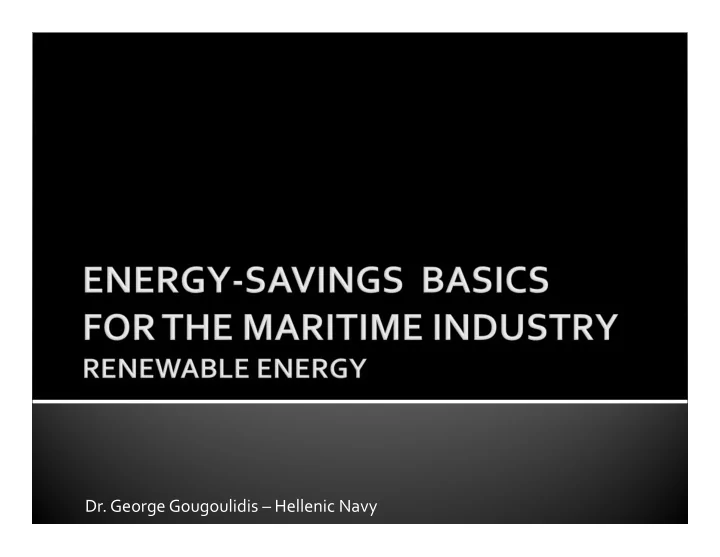

Dr. George Gougoulidis – Hellenic Navy
Wind energy Solar energy Combinations Photovoltaic Sails Kites Flettner rotors Wind turbines cells Traditional Rigid ‐ foils
Maltese Falcon – 88m superyacht
Hybrid sailing 8000 DWT multi ‐ purpose cargo vessel for Fairtransport BV 4 Dynarig masts ~ 4000 m² Diesel electric propulsion system of 3.000 kW
LOA = 138 m Draft max = 6.50 m Airdraft = 62.50 m (Panamax) Deadweight @ 6.50 m = 8210 tn Displacement = 11850 tn Design speed on engines = 12 kt Max speed on sails = 18 kt
Simple sail structure with good lift performance between 90° and 170° Collapsible & mastless
OCEANFOIL ‐ WINGSAIL WINDSHIP
2 x 35 m high masts 3 aerodynamic wings per mast Automatic rotation of masts System tested by LR It can provide 50% of thrust under favorable conditions
University of Tokyo & major shipping companies (2009) “Sail main, Engine assist” Sail height x width = 50m x 20m ~ 30 % average energy savings per year on a 84,000 tn bulk carrier with 4 sails
In Jan 2014 on ‐ land test for a retractable rigid sail (1/2.5 size)
SWIFT WINGS SHIN AITOKU MARU FORMER USUKI PIONEER
SkySails GmbH
5 ships Theseus and Michael A L = 90 m 3,700 dwt Main engine = 1,500 kW Sail area = 160 m² SkySails GmbH
Based on the Magnus Effect Velocity field change → pressure field change → force
Developed by Anton Flettner in 1924 Official presentation of Rotor Ship in Hamburg in 1925 Voyage to New York in 1926 2 rotors 15m high, 3m diameter
The rotors need another energy source Usually driven by electric motors The power needed for the rotors is considerably smaller to the thrust produced 8 ‐ 10 times more thrust than sails of equal surface area
The ship cannot sail downwind or upwind Side winds will produce thrust The rotors can also be used to slow the vessel down, or to assist in maneuvering Availability of space and general arrangements
4 Flettner rotors 27 m tall, 4 m in diameter
Rotors interfere with crane operations Solution: telescopic or foldable Flettner rotors WindAgain designed a range of Collapsible Flettner Rotors (CFR)
Wing flap to enhance performance Folded when not in use
Fuel savings ↓ as the ship size ↑ For small ships savings up to 60% have been achieved Savings of up to 19% on VLCC are being modelled Enercon reported in 2013 that the E ‐ Ship 1 had achieved 25% savings after 170 000 sea miles
They allow sailing against the wind Directly coupled to a water propeller, or used to produce electricity
An international association has been created last October to facilitate and promote wind propulsion for commercial shipping worldwide
Earth’s average solar irradiance on the surface is approximately 342 W/m² On average, 30% of this radiation will be reflected back to space due mainly to clouds The amount of energy captured depends on efficiency and positioning Current solar cells’ efficiency ~13%
Current Current best Future Approximate energy conversion efficiency (%) 13 30 60 Nominal power (W/m 2 ) 44 103 205 Power adjusted for reflection (W/m 2 ) 31 72 144
Tanker: L=270 m & B=50 m 1 main engine @ 18,000 kW, and auxiliary power 1,000 kW Tanker’s deck area completely covered by solar cells Current Current best Future Approximate energy conversion efficiency (%) 13 30 60 Nominal power (kW) 609 1406 2811 Power adjusted for reflection (kW) 426 984 1968
Car carriers Auriga Leader & Emerald Ace Part of the vessel’s electricity is generated via solar panels Hybrid electric power supply system 768 ‐ panel 160kW solar generation system Lithium ‐ ion storage battery system of 2.2MWh Used while in port Charging time: 3 days underway
Length: 199.9 m, Beam: 32.26 m
Craig Loomes design Launched 3/2010 in Kiel First solar ‐ powered trip around the world in 584 days (May 4, 2012) L = 31 m B = 15 m
Higher capital expenditure Performance depends on weather conditions Good overall performance Bulky and heavy equipment Limited to certain types of ships Small number of applications – maturity May need new classification rules Insurance
Companies adopting an Energy efficiency energy efficiency technology adopted technology in the last 5 years 30% 14% hull coatings other technology adopting 70% not adopting 86%
The UCL study shows that the maritime industry prefers easy ‐ to ‐ apply and well ‐ proven technological solutions Not foreseeable in the near future whether renewable energy sources will gain extensive popularity among shipbuilders and owners They will take a small share of the energy efficiency market
Eurostat
19 ‐ 3 ‐ 2015
Recommend
More recommend